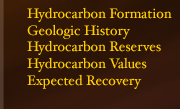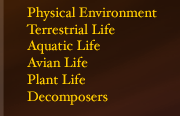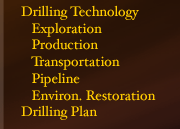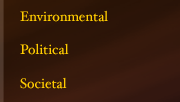
Conclusion
The fragile nature of tundra habitats and the uniqueness of the ANWR wilderness makes the principal consideration when developing an extraction strategy the mitigation of environmental disruption. Looking at past construction in the Alaskan North Slope, it becomes clear which methods damage the underlying ecology and which are relatively benign. Some newer technologies, such as elevated platforms, have been employed quite successfully while other more damaging methods, such as gravel roads, have gained increasing criticism. The resulting plan for exploration, development, production, and restoration is as close to ³environmentally correct² as specified by the assignment as we believe can be accomplished while still extracting a significant amount of oil from ANWR.
Because of the need to traverse almost all of the affected region, exploration methods have been an area of special concern. Modern oil development virtually requires seismic exploration to maximize recovery potential while minimizing the number of necessary platforms and wells. Should the studies of 1984-85 prove to be insufficient to locate oil reservoirs, further seismic exploration can be conducted with vibrosies trucks modified with rolligon tires and restricted to seasons and places with sufficient snowfall to protect the tundra. The traditional work camps that follow the equipment will be abandoned and the seismic crews greatly reduced in size. Should this method succeed as planned, the impact from exploration will be minimal.
Once exploration has finished, we advocate the selection of drilling sites with close environmental guidelines and then the construction of such sites on elevated platforms. Operating like their offshore brethren, such platforms should have minimal impact on the local vicinity and be considerably easier to remove than the gravel alternative. A network of elevated pipelines will be erected between these platforms and joined to the pipeline will be small cog railway for maintenance and emergency repairs. All platform materials will be transported to the respective sites by air and the pipelines will be erected by shuttling equipment along the cog rail. The bottom line of the plan is to have structures which can be easily removed and no roads whatsoever within ANWR.
Despite the minimization of impact in the above plan, we also strongly advocate a serious and intensive restoration effort following the end of oil production. All structures should be disassembled and removed. The tundra should be revegetated and the habitat otherwise restored as much as possible to match the state of the surrounding ecosystem. Only then will the extraction project be complete.
But no matter how much care can be taken to minimize the impact of resource extraction, drilling in ANWR will have a negative environmental impact and so it becomes necessary to evaluate whether it is worth engaging in even the best possible method of extraction. A cost-benefit analysis was performed from the prospective of American society to determine if the economic benefits of the oil likely to be extracted from the undeformed region outweighed the social cost of the environmental damage likely to result from the process. The economic benefit was found by multiplying the expected recovery by the probable market price and then by a multiplier to find the total economic benefit with the result being $594 billion +/- 7.4%. The social cost was found by considering ANWR to function as untapped natural capital whose sole worth was its existence value and then integrating the decline and recovery of that value¹s annual yield over the interval of disturbance. The result obtained, $123 billion, was significantly less than the calculated social benefit of oil extraction.
The data from the cost benefit analysis, therefore, indicates that insofar as this model can measure, it is in the interest of American society to open the undeformed region of 1002 in ANWR to hydrocarbon extraction as specified in the strategy summarized above. This does not by any means constitute advocacy for reversing the recent decision of Congress, nor for opening all of the costal plain to development by all possible methods. We strongly advocate that the deformed region of the 1002 area not only remain closed, but be declared wilderness in exchange for the opening of the undeformed area. Furthermore, the strategy outline above was developed to have the least possible environmental impact and we advocate that any future decision to drill in ANWR take this as the central design principal. The profitability of oil extraction was not and should not be an issue of concern if it would reverse the social cost-benefit analysis. Whether or not any single oil corporation or consortium thereof would ever drill in ANWR with the plan outlined above is a matter for the industry to decide for itself. The above analysis merely concludes that it is in society¹s interest for such drilling to occur as the benefits from the extracted hydrocarbons would most likely outweigh the social harm their extraction would cost in the form of environmental damage.
There is, however, a great deal of further study which must be done before any major decision can be reached. As stated in the cost-benefit analysis, a significant amount of research remains to be done in quantifying environmental damage, especially deeply intangible elements such as the social value of ³wilderness.² Other social factors, such as the disproportionate impact of a decision to drill on Alaskan citizens and especially Alaskan natives, need to be considered. Thorough environmental and geological field tests on the impact of development on the ANWR ecosystem and the exact nature of the buried hydrocarbons would also be essential to making this decision as the data from which we have worked is in many cases outdated and/or incomplete. Many of the technologies suggested in this report also require further feasibility and impact studies - low impact seismic exploration, onshore platforms, and especially the proposed cog rail accompanying the pipeline. In short, much study remains.
What has been presented here is a start and hopefully a road map for devising the ideal drilling plan to employ in ANWR and then the methodology for evaluating the social worthwhile of such a plan. It is our hope that what we have articulated here will be of use as an intellectual stepping stone to an ultimately beneficial decision. It is also our hope that this work will not be taken out of context or employed without its many caveats and that in any event a great deal more research and thought will be dedicated without bias to this challenge. ANWR has significant economic potential to offer us, but it is also an irreplaceable national treasure. It is our hope above all that care, discretion, and sound impartial science will be used to determine the future of ANWR - and of our environment as a whole.





